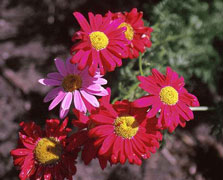


Home
Flowers &
Indoor Plants
Fruits & Nuts
Ornamentals
Vegetables
Special Topics
Resources
Glossary

|
Chrysanthemum; Garden Chrysanthemum Chrysanthemum x morifolium (kris-an-the-mum more-ah-fole-ee-um) |
 |
What about it? Chrysanthemum is Greek for "gold flower." The Chrysanthemums are a large group of popular garden flowers characterized by a distinct odor, alternating, lobed leaves, and composite flowers. There are many different species: Arctic chrysanthemum (C. arcticum with white-tinged ray flowers, feverfew (C. parthenium) with tiny, daisy-like flowers, Shasta daisy (C. maximum), and the Clara Curtis mum (C. zawadskii). There are also many different varieties of these species. The garden or florist's mum is the most popular and the hardiest for outdoor planting. It comes in yellow, red, pink, lilac, and white, and the flowers range from 1 to 12 inches. Morifolium is Greek for "mulberry leaves"; notice the gray, hairy, mitten-shaped leaves. The garden chrysanthemum will grow between 1 and 2 feet tall. What is it used for? The garden chrysanthemum is very popular; it is a perennial used as a border or an edge plant, in a container or a pot, or for cut flowers. Yellow and bronze are the most popular colors although white and reddish-pink varieties are available. It flowers around September. Where does it grow? How do we grow it? Chrysanthemum needs a well-drained soil, especially for overwintering. Planting in a soil with high organic matter will encourage stolon formation and deeper rooting. Do not plant until the danger of frost has passed. Chrysanthemums need full sun and should have 18-24 inches between them. Pinch the new growth back until mid-July and provide plenty of water if the season is dry. Staking may be necessary to provide support. What are its primary problems? Chrysanthemums are susceptible to aphids and plant bugs, leafspot and stunt, and foliar nematodes. However, they will benefit from winter protection, (i.e., mulching). Chrysanthemums may "frost heave" in early spring. How do we propagate it? Chrysanthemums can be propagated by division, cuttings, or seeds.
© Copyright, Department of Horticulture, Cornell University. |